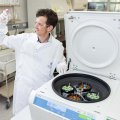UQ medical researchers and specialists from the Royal Children’s Hospital have successfully treated a young burns patient 1000 km away, via email.
PhD researcher Anthony C Smith of UQ’s Centre for Online Health was part of the team that used telemedicine for the post-acute management of the boy’s injury.
The case was published in the latest issue of the Journal of Telemedicine and Telecare, and has made news around the world, featuring on the ABC, BBC, New York Times and Reuters websites.
The 14-year-old boy, from regional Queensland, sustained a 2% full-thickness burn on his left calf from a motorcycle exhaust.
He received emergency care at a local hospital for four days, before being transferred 1100km to the Stuart Pegg Paediatric Burns Unit at the Royal Children’s Hospital in Brisbane.
He spent about three weeks in hospital, where he received two skin grafts for the burn, considered very serious.
Eager to return home but with the burn still requiring frequent monitoring, the patient and his family were referred to the Centre for Online Health’s Telepaediatric Research Project, based at the Royal Children’s Hospital.
It was here that a strategy was developed to deliver specialist management advice direct to the patient’s home, using fairly common communication techniques such as email.
The boy’s mother emailed researchers images of the injury every second day for eight weeks, then once a week for the next 12 weeks.
After studying the images, the Brisbane team could liaise with the family by telephone and provide advice on the appropriate ongoing care for the burn.
Mr Smith said digital images of the boy’s burns were taken in an unconventional way. The boy placed his calf on a desktop scanner, hooked up to a PC.
“I was impressed with the quality of the images – particularly given the unusual method of obtaining them. They had remarkable clarity!” he said.
The wound healed successfully, without the boy and his mother travelling again to Brisbane.
Mr Smith said he was pleased to help the patient achieve such a positive outcome.
“This case highlights the value of telemedicine for children living in remote areas of Queensland,” he said.
“For post-acute burns treatment, children often return to Brisbane for review by the burns team and then return back home – usually on the same day. For some families this means a full day’s travel by car or return flights to and from their regional area.
“Consultations ‘at a distance’ via videoconference or email, have enabled patients to obtain more convenient access to specialist services without the disruptions and expenses associated with travelling to a specialist centre.
“Telehealth really can enhance the delivery of health care to patients with the potential for substantial financial savings for both the patients and the health service provider.”
The Telepaediatric Research Project is funded by the Commonwealth Government and led by the UQ Centre for Online Health in collaboration with the Royal Children’s Hospital, Brisbane.



